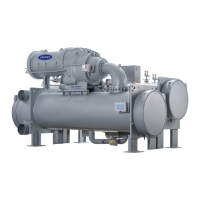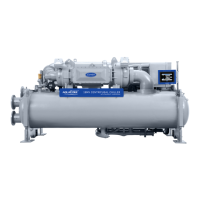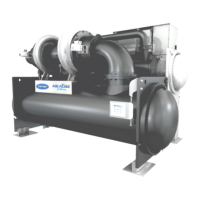46
Periodically vacuum accumulated debris on the internal
parts. Use electrical cleaner for electrical parts as required. Per-
form visual inspection of the capacitors located on the DC bus
and inductors. Check cooling fan operation. Check condensate
drain for the VFD enclosure
Power connections on newly installed starters may relax
and loosen after a month of operation. Turn power off and
retighten. Recheck annually thereafter.
Recalibrate Pressure Transducers — Once a year,
the pressure transducers should be checked against a pressure
gage reading. Check all pressure transducers: evaporator pres-
sure, condenser pressure, refrigerant pump inlet pressure, re-
frigerant pump outlet pressure, bearing inlet pressure, bearing
outlet pressure, and optional evaporator entering and leaving
water pressure, as well as condenser entering and leaving water
pressure. See Fig. 30.
Recalibrate Temperature Thermistors — Entering
chilled water (ECW), leaving chilled water (LCW), entering
condenser water (ECDW), leaving condenser water (LCDW).
Ordering Replacement Chiller Parts — When or-
dering Carrier specified parts, the following information must
accompany an order:
• chiller model number and serial number
• name, quantity, and part number of the part required
• delivery address and method of shipment.
Carrier Inhibitor — Add Carrier Inhibitor to evaporator
after every 5 years of service. Carrier Inhibitor (Carrier Materi-
al Spec RW01-26) should be added to 500 ppm concentration
when compared to nameplate total refrigerant charge.
TROUBLESHOOTING GUIDE
Overview —
The PIC5 control system has many features
to help the operator and technician troubleshoot a 19DV chiller.
• The HMI shows the chiller’s actual operating conditions
and can be viewed while the unit is running.
• The HMI default screen indicates when an alarm occurs.
Once all alarms have been cleared (by correcting the
problems), the HMI default screen indicates normal
operation. For information about displaying and resetting
alarms and a list of alert codes, see the 19 Series Controls
Operation and Troubleshooting Manual for PIC5.
• The Configuration menu screens display information that
helps to diagnose problems with chilled water temperature
control, chilled water temperature control overrides, hot gas
bypass, surge algorithm status, and time schedule operation.
• The quick test and quick calibration feature facilitates the
proper operation and test of temperature sensors, pres-
sure transducers, the guide vane actuator, refrigerant
pump, water pumps, tower control, and other on/off out-
puts while the compressor is stopped. It also has the abil-
ity to lock off the compressor and turn on water pumps
for pumpout operation (Maintenance Menu). The HMI
shows the temperatures and pressures required during
these operations.
• If an operating fault is detected, an alarm indicator is dis-
played on the HMI default screen. A more detailed message
— along with a diagnostic message — is also stored in the
Current Alarms table.
• Review the Alarms History table to view other less criti-
cal events which may have occurred. Compare timing of
relevant events and alarms.
For detailed information about alarms, see the 19 Series
Controls Operation and Troubleshooting Manual for PIC5.
Press the bell icon in the top right corner of the home screen to
access current alarms and alarm history, and to reset alarms.
Checking Display Messages — The first area to check
when troubleshooting the 19DV is the HMI display. Status mes-
sages are displayed at the bottom of the screen, and the alarm
icon indicates a fault. For a complete list of alarms, see the 19 Se-
ries Controls Operation and Troubleshooting Manual for PIC5.
Checking Temperature Sensors — All temperature
sensors are thermistor-type sensors. This means that the resis-
tance of the sensor varies with temperature. All sensors have
the same resistance characteristics. If the controls are on, deter-
mine sensor temperature by measuring voltage drop; if the con-
trols are powered off, determine sensor temperature by measur-
ing resistance. Compare the readings to the values listed in
Tables 16 and 17.
RESISTANCE CHECK — Turn off the control power and,
from the module, disconnect the terminal plug of the sensor in
question. With a digital ohmmeter, measure sensor resistance
between receptacles as designated by the wiring diagram. The
resistance and corresponding temperature are listed in
Tables 16 and 17. Check the resistance of both wires to ground.
This resistance should be infinite.
VOLTAGE DROP — The voltage drop across any energized
sensor can be measured with a digital voltmeter while the con-
trol is energized. Tables 16 and 17 list the relationship between
temperature and sensor voltage drop (volts dc measured across
the energized sensor). Exercise care when measuring voltage to
prevent damage to the sensor leads, connector plugs, and mod-
ules. Sensors should also be checked at the sensor plugs.
CAUTION
Loose power connections can cause voltage spikes, over-
heating, malfunctioning, or failures.
CAUTION
Relieve all refrigerant pressure or drain the water before
removing any thermowell threaded into the refrigerant
pressure boundary. Failure to do so could result in personal
injury and equipment damage.

